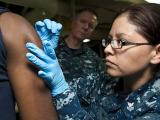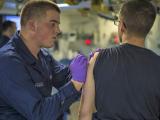Sep 12, 2003 (CIDRAP News) In response to criticism from smallpox expert Dr. D. A. Henderson, the senior author of a recent study on smallpox immunity has defended his group's conclusion that a single smallpox shot may provide at least some protection for decades or even for life.
The standard view has been that smallpox immunity wanes after a few years and that most adult Americans who were vaccinated in childhood have little, if any, protection left. But Mark Slifka, PhD, and his colleagues reported in Nature Medicine that they found surprisingly stable levels of antibodies to vaccinia (the live virus used in smallpox vaccine) in people who had been vaccinated up to 75 years previously (see CIDRAP News story, Aug 19). The researchers, from Oregon Health and Science University (OHSU), also reported evidence of T-cell memory of vaccinia up to 75 years after vaccination.
They wrote that these findings, in combination with epidemiologic evidence, indicate that a smallpox shot can impart much more lasting protection than was previously believeda possibility that they suggest has implications for smallpox preparedness policy.
Henderson, who led the successful smallpox eradication campaign of the 1960s and 1970s and is now a special advisor to Health and Human Services Secretary Tommy Thompson, subsequently critiqued the Oregon group's conclusions in an interview with CIDRAP News (see Aug 21 story). He said the weight of the epidemiologic evidence is that protection begins to fade after 5 to 10 years. He also argued that no one knows what level of antibodies signals protection, because little research on the subject was done when smallpox still existed and because antibody levels are difficult to measure reliably. He concluded that the US population remains highly susceptible to smallpox and that the new findings should not influence smallpox preparedness policy.
After reading Henderson's comments, Slifka, who is an assistant professor in the OHSU Vaccine and Gene Therapy Institute, sent a detailed response to CIDRAP News by e-mail. He contends that both the immunologic evidence and the epidemiologic evidence for lasting protection provided by a smallpox shot is much stronger than described by Henderson.
Immunologic evidence
Henderson said no one knows what level of antibodies or T-cell memory actually translates into protection. In their report, the Oregon researchers cited two studies from the 1970s that linked a specific level of neutralizing antibodies with protection against smallpox, but Henderson said those studies were too small to be convincing. Further, he said it's not possible to compare the antibody titers found in the older studies with those seen in the new study because measurement techniques have changed and findings vary so much between different laboratories even today.
In his reply, Slifka said he and his group were skeptical when they read the first 1970s study (Mack TM, et al, Am J Trop Med Hyg, 1972;21:214-8) that linked high levels of antibody with protection, but they "sat up and took notice" when they came across the second study, done by another group (Sarkar JK, et al, Bull World Health Org, 1975:52:307-11). Both were prospective studies. "It is somewhat surprising to think of these studies as being too small to be definitive, especially since the combined total of smallpox contacts that were monitored exceeds . . . 200 individuals," he wrote.
Besides the two 1970s studies, Slifka said he found another small study (Downie AW, McCarthy K, J Hyg, 1958;56:479-87) that yielded telling findings. In it, antibody levels were examined after people had contracted smallpox, and those who had the highest antibody levels were the most likely to survive the disease, he wrote.
Slifka observed that the previous reports did not address the question whether higher antibody levels were associated with higher levels of T-cell memory of vaccinia. His own group was able to compare antibody titers with virus-specific cellular immunity, and they found no correlation. "In other words, high levels of antibody correlate with protection but they don't correlate with higher levels of T cell immunity," he wrote. "This indicates that antibody plays a much more important role in protection against smallpox than anyone might have expected."
As for comparing antibody titers from different labs and different times, Slifka acknowledged that it presents problems. "For this reason, we researched the methodology used by the larger of the two prospective studies and went to great lengths to use the same techniques," he stated. In addition, they checked the antibody titers using modern techniques, including ELISA (enzyme-linked immunosorbent assay), so that other researchers can repeat the study.
Henderson told CIDRAP News he lacked the time to respond to Slifka's comments in detail, but he stood by his critique. Concerning the antibody findings, he stated in an e-mail, "The authors have tried to replicate methods, etc and to utilize some sort of methodology that resembles those used in the two studies cited (one of which had 3 smallpox cases and the other 6) and to argue that we can have some confidence in neutralizing antibody as a surrogate marker for protection. . . . It is not possible to know how their ELISA results compare with a neutralizing antibody study done 30 years ago." He added that he still has no confidence in neutralizing antibody as an index of protection.
Epidemiologic evidence
As noted above, Henderson said the epidemiologic evidence is that immunity to smallpox begins to wane between 5 and 10 years after vaccination. But Slifka said his group couldn't find any published studies showing that "immunity against smallpox itself is completely lost within 5-10 years after vaccination." "Although we were able to find substantial evidence indicating prolonged and sometimes even lifelong immunity against smallpox after a single vaccination, we were unable to locate the studies . . . Dr. Henderson is referring to."
Henderson said it's been known since the time of Edward Jenner, who developed the smallpox vaccine in the 18th century, that a single vaccination doesn't confer lasting immunity. Slifka, however, responded that Jenner himself presented evidence that the vaccine offers lasting protection.
"In his first report on the theory that cowpox inoculation could protect against smallpox (1798), Dr. Jenner provided several case studies in which he demonstrated that people were fully protected against smallpox inoculation even though it had been . . . 25 to 38 years since they had been infected with smallpox," Slifka wrote. Jenner wrote that these cases occurred in rural areas where smallpox was not endemic, and therefore the vaccinees' immunity could not have been boosted by exposure and subclinical infection. Later, Jenner cited the case of a man who fully resisted the disease 53 years after he was vaccinated, according to Slifka. [See errata below.]
Henderson, in his critique, also objected to Slifka's characterization of a 1972 British epidemiologic study. Henderson said the study showed a smallpox mortality rate of 11% in people who had been vaccinated at least 11 years before exposure, not the 6% to 7% mentioned by Slifka et al. Slifka agreed that 11% was the overall rate for the three groups in the study. But one of the groups consisted of hospital patients, and Slifka said he excluded them because he didn't know their previous health status or reason for hospitalization. He looked only at the other two groupshospital staff and their contacts and the publicbecause they were most comparable to the volunteers in his study. The 6% and 7% rates applied to those groups combined, depending on years since vaccination.
Henderson also said Slifka failed to mention that 473 of the 561 smallpox patients in the 1972 study had been vaccinated but contracted the disease anyway. In reply, Slifka cited evidence that most vaccinated people, when exposed to smallpox, do not get sick enough to have symptoms, and suggested that the 473 people were among the minority who do contract clinical disease despite their vaccination. He wrote, "Only the people who contract clinical symptoms of smallpox were counted in these studies, and this number does not necessarily represent all of those who were actually exposed to the virus."
He cited a meta-analysis (from the smallpox text by Fenner, Henderson, and others, Smallpox and Its Eradication [chapter 4, page 200]) of 10 epidemiologic studies that indicated that 3.8% of previously vaccinated people, when exposed to smallpox, experienced clinical illness. "This means that about 96% of vaccinated individuals that are exposed to smallpox do not appear to get infected with the virus," he wrote. In the 4% who do get sick, "the disease is typically milder (described as a 'modified' form of smallpox) and, as stated above, the mortality rates are 7% or less. If we made conservative estimates of a 10% attack rate (instead of 3.8%) and a 10% mortality rate of those attacked (instead of 7%), then this would still be indicative of a 99% overall survival rate in people previously vaccinated against smallpox!"
Henderson, in response to Slifka's points on the epidemiologic issues, simply stated, "It would be most reassuring to suggest that most everyone vaccinated once was protected for life but there is an overwhelming amount of data that suggest otherwise. Note that I did not say that Jenner believed revacciation was necessary. I said that even in Jenner's time, it had become apparent that a single vaccination did not protect indefinitely. Like Salk and Sabin, Jenner had a baby and, as he saw it, the baby had no faults, only those employing it!"
Policy implications
In his original critique, Henderson said that probably no more than half of Americans who received smallpox shots in childhood still have any protection. He estimated that the rest of the populationat least 72%have no immunity because they were never vaccinated or the protection provided by their childhood shot has faded. He concluded that the study by Slifka et al has no implications for current vaccination policy or outbreak response planning.
But Slifka insisted that his study provides "concrete evidence of long-term immunity following smallpox vaccination" that is supported by much historical evidence. "The most important point that we wanted to make is that a lot more people would survive a smallpox epidemic than previously believed," he stated. "This is not triviala mild or modified case of smallpox surely beats dying of smallpox."
In an outbreak, people with mild or moderate disease owing to their partial immunity would be less likely to spread the virus to others, Slifka added. He quoted Fenner and Henderson's text as stating that people with modified smallpox were four times less likely than unvaccinated people to transmit the disease to household contacts (chapter 4, pages 189-90). "When you take into account that more than 100 million people in the U.S. are guaranteed to have at least partial immunity against smallpox, you can begin to see its direct relevance to outbreak response planning and to basic homeland security," he concluded.
Federal health officials, for their part, have not signaled any intention to review smallpox preparedness policies in the light of Slifka's study or other recent reports on the duration of smallpox immunity. In a recent Associated Press report, Anthony Fauci, MD, PhD, director of the National Institute of Allergy and Infectious Diseases, said the new findings don't change the fact that half of Americans have never had a smallpox shot. He also said vaccination is still important for those who would have to respond to a smallpox outbreak, because a recent shot is the only thing that provides optimal protection.
See also:
Fenner F, Henderson DA, Arita I, et al. Smallpox and Its Eradication. World Health Organization, 1988 [Full text]
[Errata (Sep 29, 2003) The section headed "Epidemiologic evidence" in the above article contains two errors resulting from unintentional misquotes of statements by Mark Slifka, PhD. In describing the work of Edward Jenner, who developed the smallpox vaccine, Slifka wrote, "Dr Jenner provided several case studies in which he demonstrated that people were fully protected against smallpox inoculation even though it had been between 25 to 38 years since they had been infected with cowpox"not smallpox (italics added). Similarly, Slifka wrote that Jenner had cited the case of a man who fully resisted smallpox 53 years after he had had cowpoxnot 53 years after he had received a smallpox vaccination.]





















